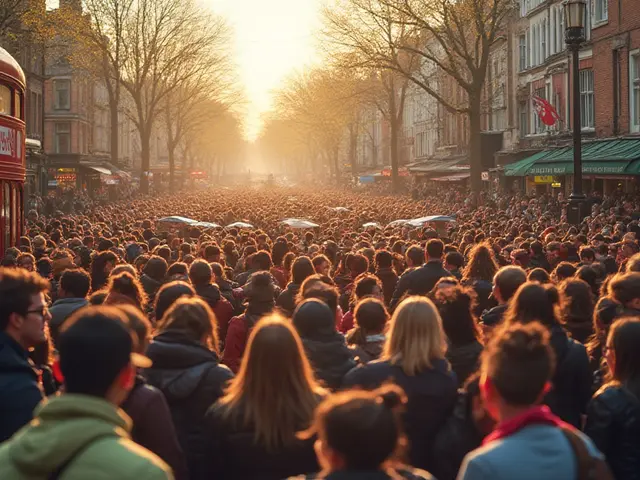When you think of London’s cultural heartbeat, it’s not just the Queen’s coronation jewels or the British Museum’s Rosetta Stone that come to mind-it’s the buildings themselves. The city’s most popular museums aren’t just containers for art and history; they’re architectural masterpieces that tell stories before you even step inside. From Victorian grandeur to modernist boldness, London’s museum architecture is as diverse as its population. And if you’ve ever stood in front of the British Museum’s colonnade or gazed up at the Tate Modern’s turbine hall, you know: these aren’t just places to see exhibits. They’re places to feel awe.
The British Museum: Classical Power in Bloomsbury
The British Museum isn’t just the largest collection of human history in the UK-it’s a temple to empire, built in the 1850s with a design that screams authority. The east wing, with its 44 Ionic columns, was inspired by the Parthenon, a deliberate nod to the ideals of ancient Greece that Victorian Britain wanted to claim as its own. The Great Court, redesigned by Norman Foster in 2000, turned the museum’s inner courtyard into Europe’s largest covered public square. Glass and steel meet stone, and suddenly, the museum feels both ancient and alive. It’s the kind of space where you can pause under the glass roof, sip a coffee from the on-site café, and watch students sketch the sculptures while tourists snap selfies with the Rosetta Stone behind them.
Pro tip: Visit on a weekday morning. The light through the glass ceiling hits the Egyptian statues just right, and you’ll avoid the tour groups that swarm in after 11 a.m. The museum’s free entry (a policy unchanged since 1759) means you can come back again and again-each time noticing something new in the stonework or the way the shadows fall across the columns.
Tate Modern: From Power Station to Cultural Icon
On the south bank of the Thames, the Tate Modern stands as a monument to industrial rebirth. The building was once Bankside Power Station, designed by Sir Giles Gilbert Scott-the same architect behind the red telephone boxes and Liverpool Cathedral. When it closed in 1981, the idea of turning it into a modern art museum seemed radical. But in 2000, the conversion was complete: the turbine hall became a cathedral for contemporary art, its 155-meter-long, 35-meter-high space now hosting massive installations like Olafur Eliasson’s Weather Project and Ai Weiwei’s Sunflower Seeds.
The building’s raw brick walls, exposed ductwork, and massive chimney stack aren’t just preserved-they’re celebrated. The view from the top floor’s free viewing gallery? Unbeatable. You can see St. Paul’s Cathedral, the Shard, and the Millennium Bridge all at once. Locals know to bring a sandwich and sit on the bench near the south entrance at sunset. It’s not just a museum-it’s a London ritual.
The V&A: A Palace of Decorative Arts
Step into the Victoria and Albert Museum in South Kensington, and you’re walking through a 19th-century fantasy of luxury. The building is a riot of color, tilework, and carved stone. The main entrance, with its ornate iron gates and the statue of Queen Victoria flanked by allegorical figures, was designed to impress. Inside, the Cast Courts house full-scale replicas of Michelangelo’s David and Trajan’s Column, lit by stained-glass skylights that change hue with the time of day.
What makes the V&A unique isn’t just its collection-it’s how the building itself became part of the exhibit. Every hallway, every ceiling, every staircase was designed to showcase craftsmanship. The John Madejski Garden, added in 2004, is a quiet oasis with a water feature and benches shaped like Victorian chairs. It’s the perfect place to rest after wandering through 5,000 years of design-from Chinese porcelain to Alexander McQueen dresses.
Don’t miss the ceramics gallery. The tiles on the floor? Original 1850s Minton encaustic tiles, still in place. That’s not restoration-that’s endurance.

The Design Museum: Modern Minimalism on the Thames
Move away from the grandeur of the V&A and you’ll find the Design Museum, tucked into a converted 1960s banana warehouse in Kensington. When it reopened in 2016 after relocating from its original Shad Thames site, it became a lesson in how to make architecture feel quiet but powerful. The building’s white concrete façade, floor-to-ceiling windows, and clean lines are a direct contrast to the ornate museums nearby.
Inside, the space is flexible-walls slide, partitions move, and lighting shifts to suit each exhibition. The café, designed by London-based firm Studioilse, has tables made from reclaimed oak and chairs that look like they came from a 1950s Danish living room. The museum doesn’t just display design-it lives it. Exhibits have included everything from the London Underground map to the Apple Watch. It’s the kind of place where a local architect might come to study how a bus stop is engineered, or a student from Brixton might find inspiration in a pair of sneakers on display.
The Natural History Museum: Gothic Revival Meets Science
Walk down Cromwell Road and you’ll be met by a building that looks like it was carved out of a medieval cathedral-except instead of saints, the columns are lined with dinosaurs and the stained glass depicts ferns and fungi. The Natural History Museum, opened in 1881, was designed by Alfred Waterhouse in the Gothic Revival style, but with a twist: every detail serves science. The terracotta tiles on the façade are shaped like leaves and shells, chosen to resist London’s sooty air. The central hall, with its soaring vaulted ceiling and suspended blue whale, is one of the most photographed spaces in the city.
The museum’s architecture isn’t just decorative-it’s functional. The layout was designed to guide visitors through the natural world, from the depths of the ocean to the peaks of mountains. The Darwin Centre, added in 2009, is a glass-and-steel cocoon that houses millions of specimens. It’s a perfect blend of old and new: the original building feels like stepping into a Victorian novel, while the modern wing looks like it belongs in a sci-fi film.
Pro tip: Visit during the Winter Lights event in December. The hall is lit with projections of migrating birds and glowing jellyfish, turning the museum into a living diorama. Locals line up for hours to get in.

Why Architecture Matters in London’s Museums
London’s museums don’t just collect objects-they collect moments. The way light falls through the British Museum’s Great Court, the echo of footsteps in the Tate Modern’s turbine hall, the scent of old wood in the V&A’s galleries-these aren’t accidents. They’re intentional. Each building was designed to shape how you experience what’s inside.
And that’s why, even if you’ve seen every painting in the National Gallery or every dinosaur in the Natural History Museum, you’ll keep coming back. Because the buildings themselves are the first exhibit. They’re the reason you remember your first visit. They’re why a child in Camden will say, “I want to be an architect,” after seeing the V&A’s ceiling. They’re why expats in Islington bring their parents from Tokyo or Toronto to stand under the glass roof of the British Museum and say, “This is what London feels like.”
What to Do Next
If you’ve never explored these buildings beyond their collections, start here:
- Take a free guided architecture tour at the British Museum every Saturday at 2 p.m. (book ahead-spots fill fast).
- Walk from Tate Modern to Shakespeare’s Globe along the Thames. Notice how the modern glass of the Tate contrasts with the timber-framed replica of the Globe.
- Visit the V&A’s free Architecture Gallery on the first floor-it’s full of models of London buildings you’ve walked past without noticing.
- Join the London Architecture Walks group (run by the Royal Institute of British Architects) for monthly tours of museum buildings.
And if you’re short on time? Just sit. Pick one museum. Find a bench. Watch how people move through the space. Listen to the quiet hum of a child whispering to their parent about the whale. That’s when you realize: these buildings aren’t just holding history. They’re making it.
Are London’s museum buildings free to enter?
Most major national museums in London-like the British Museum, Tate Modern, V&A, and Natural History Museum-are free to enter. Some special exhibitions charge a fee, but the permanent collections and the buildings themselves are always accessible without payment. This policy dates back to the 19th century and remains a point of national pride.
Which London museum has the most Instagram-worthy architecture?
The Natural History Museum’s central hall, with its blue whale hanging from the ceiling and the stained-glass skylights, is the most photographed. But the Tate Modern’s turbine hall and the British Museum’s Great Court are close seconds. For a less crowded shot, try the V&A’s John Madejski Garden at golden hour-it’s quiet, elegant, and rarely full of selfie sticks.
Can I take photos inside these museums?
Yes, non-flash photography is allowed in most areas for personal use. Some galleries, especially those with loaned artworks or sensitive lighting, may have restrictions-look for signs or ask a staff member. The British Museum and V&A are particularly photo-friendly, and many visitors use their phones to document architectural details like tiles, carvings, and lighting.
Is it worth visiting these museums on rainy days?
Absolutely. London’s weather is unpredictable, but these museums are among the best places to escape the rain. The Great Court at the British Museum has covered walkways and seating. The Tate Modern’s café has floor-to-ceiling windows overlooking the Thames. And the V&A’s galleries are climate-controlled, making them perfect for lingering. Locals often plan their rainy-day itineraries around these buildings.
Are there any lesser-known museum buildings in London with great architecture?
Yes. The Wallace Collection in Manchester Square is a Georgian townhouse turned museum, with gilded ceilings and a stunning staircase. The Guildhall Art Gallery, near the City of London, sits beneath the ruins of a Roman amphitheatre. And the Wellcome Collection on Euston Road blends medical history with minimalist Scandinavian design. All are free, quiet, and architecturally rich.
If you’re looking for more than just exhibits, London’s museums offer something deeper: a chance to walk through centuries of design, ambition, and beauty. You don’t need a ticket to feel it. Just show up. Look up. And let the buildings speak.



